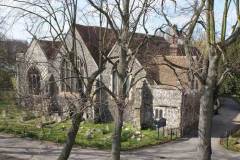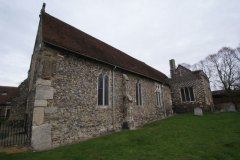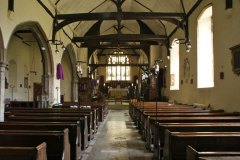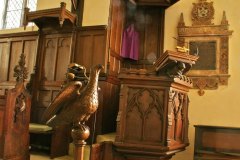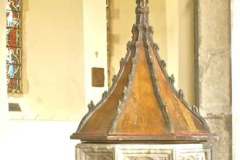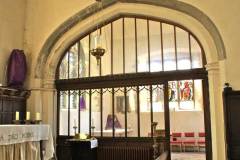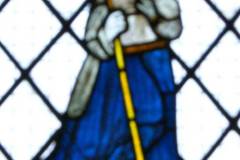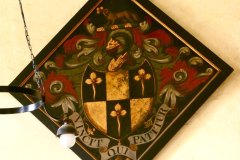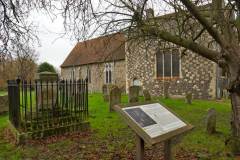6 Church Lane
Introduction
Wander to the end of Stour Street and under a copse of trees and you will find, hidden between the Castle, ring road and River Stour, the oldest Saxon church within the city, St Mildred’s.
History
St Mildred was the daughter of Ermenburga, grand daughter of King Ethelbert of Kent and consecrated Abbess of the Convent of Minster in Thanet by St Theodore, Archbishop of Canterbury in AD694. Mildred supported the poor and is usually depicted holding a deer (the symbol of Minster) or a church and three geese. She died c.732, and her tomb became a place of pilgrimage. Her relics were acquired by St Augustine’s Abbey in 1033, but Archbishop Lanfranc later also claimed them for St Gregory’s Priory in the mid 11th century. The church was founded around 1033, but virtually destroyed by fire in 1246. A tower and new roof were added in the 1300s, North aisle and Nave windows in 1400s and SE chapel in 1500s. The tower was demolished and bells sold in 1832, the whole church restored in 1861 and again in 1920s. This has left a hall church with a five bay nave, two bay chancel, North aisle, SE chapel and North porch. Izaak Walton, author of The Compleat Angler who fished for trout in the Stour, married here in 1626.
What to see:
- The church from the adjacent car park above Church Lane (Image 1).
- The Saxon walling of flint, tile and stone with very large quoins set in long and short style, possibly from the ruins of Roman Canterbury (Image 2).
- The nave and chancel arcades, windows and crown post roof constructed between the 14th and 16th centuries (Image 3).
- Wood carvings include the 1800’s lectern and poppy heads on the clergy pews, but not the stone drum pulpit expertly painted to look like wood! (Image 4).
- The 1420 font, a rare pre-reformation example with the original cover and counter balance lifting system (Image 5).
- The south east chapel built as a chantry in 1512 by Thomas Attwood, four times Mayor of Canterbury is constructed of Tudor chequered flint and freestone with external crosses (Image 2 and 6). It contains a Tudor four centred arch fireplace (no doubt to ensure the chantry priests could not use the cold as an excuse not to attend to their prayers for the souls of the family!).
- The west window of the chapel contains a stained glass figure of St Mildred (Image 7).
- A hatchment (a coat of arms for a funeral processions later hung in the church when the body was interred elsewhere) for the colourful Alderman Simmons (Image 8) whose grave is in the churchyard (Image 9)
Access: For access during Covid restrictions consult the website at https://www.dunstanmildredpeter.org.uk/welcome.htm
Sources: Pevsner and Newman (1983); http://www.britishlistedbuildings.co.uk/en-170573-church-of-st-mildred-canterbury
SR

